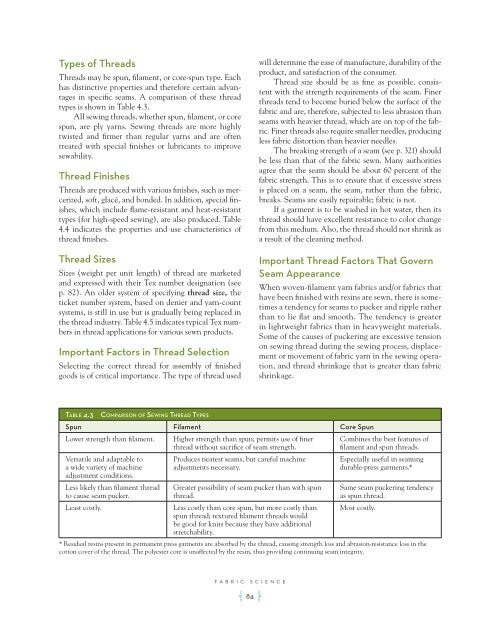You also want an ePaper? Increase the reach of your titles
YUMPU automatically turns print PDFs into web optimized ePapers that Google loves.
Types of Threads<br />
Threads may be spun, filament, or core-spun type. Each<br />
has distinctive properties and therefore certain advantages<br />
in specific seams. A comparison of these thread<br />
types is shown in Table 4.3.<br />
All sewing threads, whether spun, filament, or core<br />
spun, are ply yarns. Sewing threads are more highly<br />
twisted and firmer than regular yarns and are often<br />
treated with special finishes or lubricants to improve<br />
sewability.<br />
Thread Finishes<br />
Threads are produced with various finishes, such as mercerized,<br />
soft, glacé, and bonded. In addition, special finishes,<br />
which include flame-resistant and heat-resistant<br />
types (for high-speed sewing), are also produced. Table<br />
4.4 indicates the properties and use characteristics of<br />
thread finishes.<br />
Thread Sizes<br />
Sizes (weight per unit length) of thread are marketed<br />
and expressed with their Tex number designation (see<br />
p. 82). An older system of specifying thread size, the<br />
ticket number system, based on denier and yarn-count<br />
systems, is still in use but is gradually being replaced in<br />
the thread industry. Table 4.5 indicates typical Tex numbers<br />
in thread applications for various sewn products.<br />
Important Factors in Thread Selection<br />
Selecting the correct thread for assembly of finished<br />
goods is of critical importance. The type of thread used<br />
Table 4.3 Comparison oF sewing Thread TYpes<br />
FABRIC SCIENCE<br />
A 84 F<br />
will determine the ease of manufacture, durability of the<br />
product, and satisfaction of the consumer.<br />
Thread size should be as fine as possible, consistent<br />
with the strength requirements of the seam. Finer<br />
threads tend to become buried below the surface of the<br />
fabric and are, therefore, subjected to less abrasion than<br />
seams with heavier thread, which are on top of the fabric.<br />
Finer threads also require smaller needles, producing<br />
less fabric distortion than heavier needles.<br />
The breaking strength of a seam (see p. 321) should<br />
be less than that of the fabric sewn. Many authorities<br />
agree that the seam should be about 60 percent of the<br />
fabric strength. This is to ensure that if excessive stress<br />
is placed on a seam, the seam, rather than the fabric,<br />
breaks. Seams are easily repairable; fabric is not.<br />
If a garment is to be washed in hot water, then its<br />
thread should have excellent resistance to color change<br />
from this medium. Also, the thread should not shrink as<br />
a result of the cleaning method.<br />
Important Thread Factors That Govern<br />
Seam Appearance<br />
When woven-filament yarn fabrics and/or fabrics that<br />
have been finished with resins are sewn, there is sometimes<br />
a tendency for seams to pucker and ripple rather<br />
than to lie flat and smooth. The tendency is greater<br />
in lightweight fabrics than in heavyweight materials.<br />
Some of the causes of puckering are excessive tension<br />
on sewing thread during the sewing process, displacement<br />
or movement of fabric yarn in the sewing operation,<br />
and thread shrinkage that is greater than fabric<br />
shrinkage.<br />
Spun Filament Core Spun<br />
Lower strength than filament. Higher strength than spun; permits use of finer<br />
thread without sacrifice of seam strength.<br />
Versatile and adaptable to<br />
a wide variety of machine<br />
adjustment conditions.<br />
Less likely than filament thread<br />
to cause seam pucker.<br />
Produces neatest seams, but careful machine<br />
adjustments necessary.<br />
Greater possibility of seam pucker than with spun<br />
thread.<br />
Least costly. Less costly than core spun, but more costly than<br />
spun thread; textured filament threads would<br />
be good for knits because they have additional<br />
stretchability.<br />
Combines the best features of<br />
filament and spun threads.<br />
Especially useful in seaming<br />
durable-press garments.*<br />
Same seam puckering tendency<br />
as spun thread.<br />
Most costly.<br />
* Residual resins present in permanent press garments are absorbed by the thread, causing strength loss and abrasion-resistance loss in the<br />
cotton cover of the thread. The polyester core is unaffected by the resin, thus providing continuing seam integrity.













